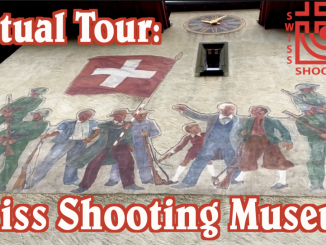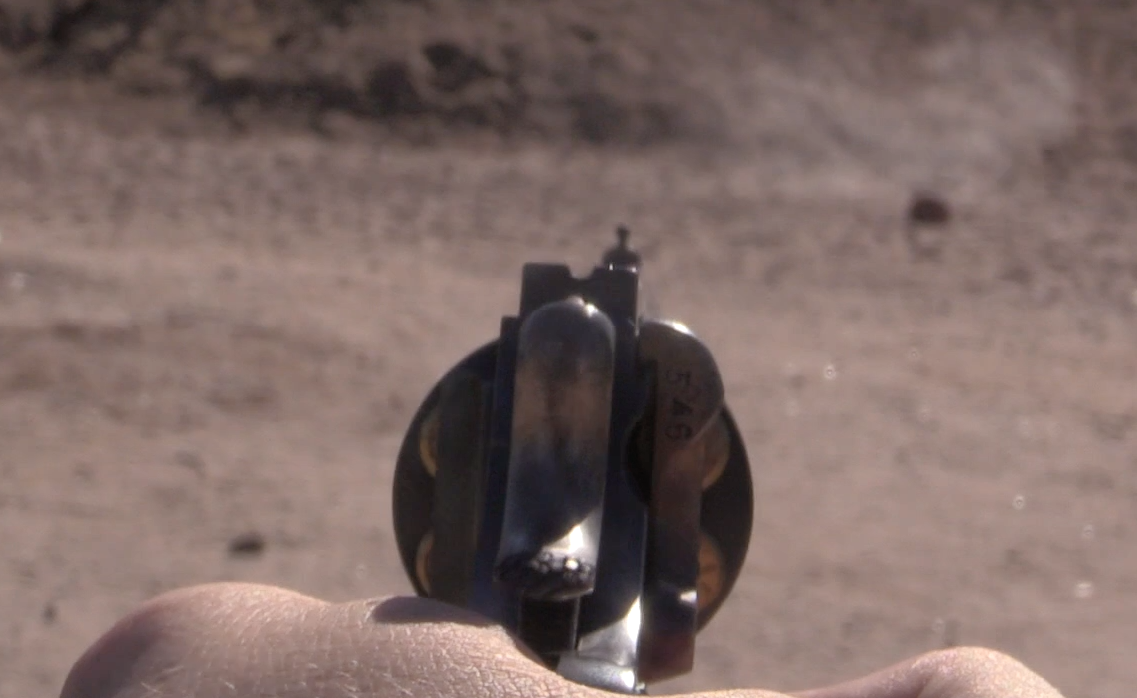When I filmed yesterday’s video on the MP-41/44, and did not know I would have a chance to actually do some live fire with it. But we snuck off to a little shooting range to have a try (sorry for the poor lighting!). The question going in for me was whether the locking system and the weight of the gun would make for a very nice shooting experience. I knew that it had a fairly high rate of fire, but didn’t know how all the elements would come together.
It turned out to be a pretty controllable weapon, not exceptionally bad but also not exceptionally good. For all the complexity that Furrer put into the design, it handled pretty much like any other typical 9mm submachine gun.
Thanks to Kessler Auktionen AG for letting me film some of their guns! If you are looking for interesting and unusual arms in Europe, make sure to check them out…




It looks like it’s much better for a left hand shooter than a right hand one.
All that brass falling on the right forearm of right-handers could be pretty unpleasant?
The Furrer MP1941/44 magazine should be relocated to the bottom for ease of access during reload operations since the right-side-mounted orientation requires the operator to hold the gun with the right hand, extend his left hand across the top of the receiver to reach the magazine, operate the release, and replace the empty magazine with a new one.
Wrong way, dude. The proper reload procedure has the left hand holding the stock while the right hand gets off the trigger and changes the magazine!! Would you rather have a nervous soldier accidentally shooting his friends during the reload cycle?
Prefer the Beretta 38A. Had many WW2 era sub machine guns but that was always my favorite.
Was that filmed in a re purposed bunker?
Just saw your knee mortar demonstration. Awesome. I’d seen and handled one. You really went deep. I always learn something from your videos!
What type of ammo was used? American commercial is too anemic for most of my guns
According to https://wwiiafterwwii.wordpress.com/2016/07/31/mp-4144-submachine-gun-post-wwii-use/
New problems were being created by the MP 41/44. During it’s early trials, the measured muzzle velocity was 1,295fps, below the SIG competitor. There were problems with using generic 9mm Parabellum rounds, in that they sometimes did not create enough recoil to effectively work the toggle-lock system. It was suggested to tweak the propellant load of Swiss military-issue 9mm Parabellum rounds, this resulted in a satisfactory 1,313fps from the MP 41/44. However it naturally led to safety concerns for pistol use; obviously there was no realistic way two “streams” of identical ammo could be maintained for MP 41/44 users and everybody else. The international organization SAAMI recommends gun designers test weapons at 30% above the expected chamber pressure, but for decades after WWII the Swiss army proofed 9mm handguns at 50% above because of the “poisoned” 9mm stockpile.
“too anemic”
Interestingly, from same link:
The Swiss army tried to rectify some issues with new operational guidelines; sometimes with unintentionally humorous results. For example, it suggested making adjustments to the spring if the gun was repeatedly fired on an incline, such as from a mountain into a valley.
So would a Swiss side-arm penetrate a vest made of American ballistic nylon?
“vest made of American ballistic nylon”
Do you mean M-1951 Armored Vest under that?
And if yes on what range?
According to http://chainlinkandconcrete.blogspot.com/2016/07/the-vest-armored-m-1951-m-1952-and-m.html
Troops in the field also mention the vest standing up to several rounds fired from a “burp” gun in 7.62 Tokarev at 20 feet
[off-top so ignore if you if wish]
Recently I found weapon named THOR A1 and classified as PDW, see images:
http://pascaleggert.de/ThorA1.html
which looks like combination of untypical features from various older weapons, including “rotate cartridge before ramming into chamber” (see animation) somewhat akin to ZB-47 sub-machine gun, forced air-cooling like Lewis light machine gun.
I think somebody took “The Street Samurai Catalog” and “Fields of Fire” for the old FASA Shadowrun</em< RPG a little too seriously. Not to mention the Resident Evil franchise.
Sort of like the designers of the KRISS Vector SMG;
https://en.wikipedia.org/wiki/KRISS_Vector
cheers
eon
Regarding untypical sub-machine guns see:
http://guns.wikia.com/wiki/Flieger-Doppelpistole_1919
was it made by Furrer or someone else?
It says it is a variant of the Furre MP19
Yes, I should read more carefully (I read fast and just concluded it used Furrer MP1919 magazine)
Interestingly also Spasov in Bulgaria crafted sub-machine gun with toggle, see 1st photo from top here: https://raigap.livejournal.com/557976.html
it is said to be reworked Parabellum-Pistole created in 1940. Data about it are scarce, however sample is hold by museum in Sofia. Feeding from 32-round drum magazine.
Better than a STEN.
For the equivalent of $5000, it’d better be!
How so? Sten loads from the left, empties fly out to the right. Same dual-column, single-feed magazines, albeit with UK web gear I suppose the magazines might rattle in exchange for being a bit easier to withdraw from the pouch. Sten fire selector seems a bit easier and more intuitive to use… Weighs less… Might even be more reliable… And costs like $9 dollars and could be made in dispersed work shops.
I’m quite sure the Suomi clone made by Hispano-Suiza was much preferable!
“I’m quite sure the Suomi clone made by Hispano-Suiza was much preferable!”
Production of Furrer sub-machine gun is example of using political connection to force worst decision, I would say Swiss soldiers would be more happy if decision of adopting SIG Model 1920 “Brevet Bergmann” would be made
https://modernfirearms.net/en/submachine-guns/switzerland-submachine-guns/sig-1920-1930-eng/
Well, I’m sure Denny would agree that the Sten had a problem with people reloading under stress and accidentally shooting their friends in the knees. The same can be said for the MP-40. The Bergmann MP-35 (and for that matter, the AK family), in contrast, was designed so that changing magazines (and operating all of the vital functions) had to be done with the right hand and there was also no chance of accidental discharge upon reloading since there would be no twitchy finger on the trigger during the reloading process.
“The same can be said for the MP-40.”
It is true to part of MP 40 examples but not all. Early production MP 40 allowed bolt locking only in rearward position, when later production allow locking both in rearward and forward (close) position, also early production could be (and were) upgraded to include this feature.
According to http://www.mp40.nl/index.php?page=the-military-manuals-2
if you reloads MP 40 without that feature you should use leather strap to prevent bolt from moving rearward.
I appreciate you carry me in your memory Cherndog. I lately do not feel as much for commenting but read what yo and other people have to say.
Yes, you are right – I am not fan of Sten. It is not only because it failed on assassin Gabchik (would be lovely to see Heidrich’s picture riddled with bullets). I also heard from Uzi his part of story and other recollections. But Sterling was a fine gun, one of the better ones. Let’s keep in mind, every design is a compromise of kind.
Respectfully, and in light of the comments by contributor Robert L above:
Adjusting for inflation, the Adolf Furrer toggle-delayed 9mm MP41 is the same cost as approximately 2 Model 1928 Thompsons with all the glorious stock furniture, “Blish principle” stuff, Cutt’s compensator, etc. and cooling fin friperies. Or about 38 Stens with change left over!
Fortunately Gabchik’s Sten seemed to work well enough when he and his SOE-trained comrades in arms were trapped in the church catacombs… French leaders conceived of a “cordon sanitaire” strategy reliant on a Czech and Polish army to Germany’s east. When the Germans re-occupied the Rhineland while Mussolini was harrowing Ethiopia and the League of Nations was moot, French generals did nothing because they were not ready for war with Germany. At Munich, the “cordon sanitaire” failed when the Czechs lost their border defenses, mooted by the Anschluß with Austria, and even Poland aggrandized territory from Bohemia and Moravia. Adding insult to injury, the Germans used the excellent Czech weapons–superior in many regards–to turn around and invade Poland–guaranteed a French offensive within 15 days!–and then to ultimately spearhead Fall Gelb und Fall Rot…! On the other hand, Polish and Czech pilots proved mighty important during the struggle for air supremacy over all-but-defeated Great Britain. The anti-invasion defenses along the coast of Fife, where my late grandmother was born and raised before she joined the British army’s “ATS” were built by Poles.
“Let’s keep in mind, every design is a compromise of kind.”
STEN (at least in Mk. II iteration) was after all sub-machine gun made for maximal cheapness to allow dispersed (hence no stamping) production of big quantity. also it was first widely produced sub-machine gun of British manufacture, so it is not surprise it is inferior to sub-machine gun having bigger experience with sub-machine gun, on the other hand Australia (also no prior experience with sub-machine gun) got OWEN sub-machine gun, which is IMHO superior to STEN from user point of view, however I am not sure if it could be produced so cheaply/in so vast numbers.
is: “(…)STEN(…)”
should be: “(…)STEN Mk.II(…)”
Seems a bit too high a rate of fire?